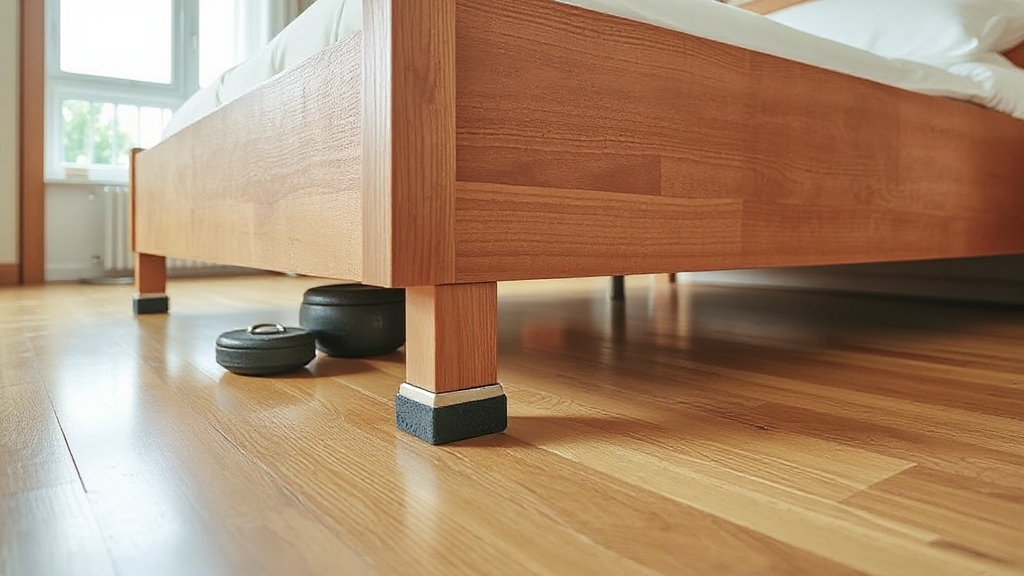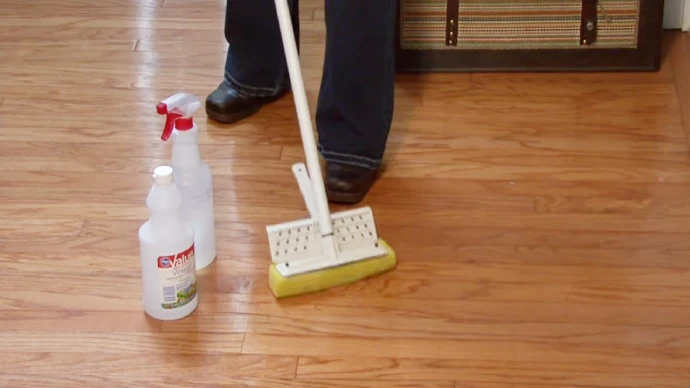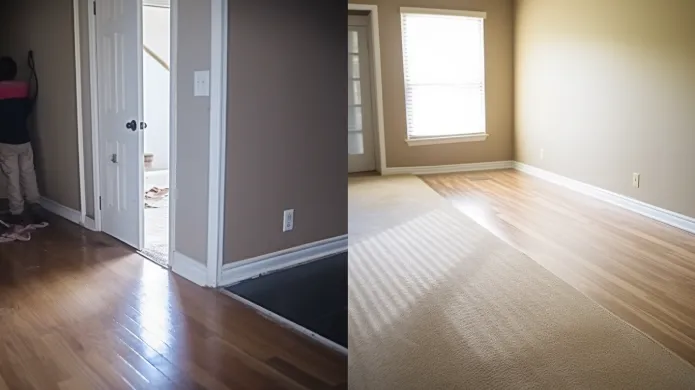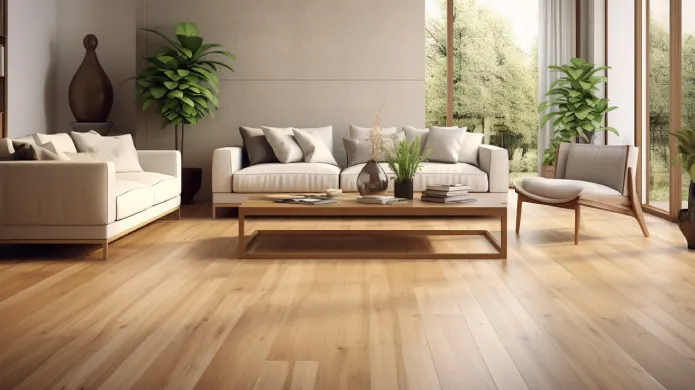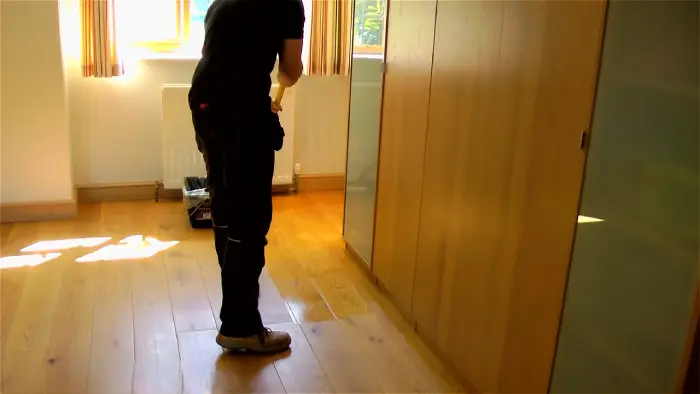How to Keep a Bed From Moving on Hardwood Floors: Stop Slide
You can keep your bed from sliding on hardwood floors by using rubber furniture grippers or pads under the legs to increase friction and protect your floor.
Wrapping bed legs with rubber or adding a non-slip rug pad beneath an area rug also helps stabilize it. Double-sided tape offers a temporary fix when applied carefully.
Combining these methods and maintaining them regularly guarantees long-term stability without damaging your floors. There are even more practical tips and solutions to explore for lasting results.
Key Takeaways
- Place rubber or silicone furniture grippers under each bed leg to increase friction and prevent sliding on hardwood floors.
- Use a non-slip rug pad with an area rug extending beyond the bed frame for added stability and floor protection.
- Wrap bed legs with rubber or attach adhesive rubber feet to reduce movement and protect the floor surface.
- Apply commercial double-sided tape beneath bed legs as a temporary measure to secure the bed in place.
- Combine multiple methods and regularly inspect and clean anti-slip materials to maintain long-term bed stability.
The Causes of Bed Movement on Hardwood Floors
Although your bed may seem sturdy, it can easily slide on hardwood floors due to their smooth surface and low friction. Hardwood finishes and regular polishing make floors slicker, increasing sliding risks.
Beds with metal or smooth wooden legs slide more than those with rubber padding, and frames on casters move even easier. Using protective pads or mats can reduce movement by increasing floor friction.
Your daily movements turning, getting in and out can cause the bed to shift over time. Different hardwood types like oak or maple offer slight friction variations, but sliding remains common.
Environmental factors like humidity also affect floor smoothness, influencing bed stability. Additionally, uneven or worn-down bed legs contribute to wobbling and increase the likelihood of sliding.
Sliding beds not only disrupt your sleep but can scratch floors and misalign furniture. Understanding these causes helps you identify why your bed shifts and prepares you to address the issue effectively.
Choosing the Right Non-Slip Solutions for Hardwood Flooring
When you want to stop your bed from sliding on hardwood floors, choosing the right non-slip solution makes all the difference. For quick, removable traction, non-slip furniture cups in wood grain finishes blend well with your floor while securing bed legs.
If your bed is heavy, EVA foam pads distribute weight and protect flooring from scratches. It is also important to avoid harsh chemicals on hardwood to maintain the floor’s finish.
Clear silicone or rubber bumpers stick to bed legs invisibly and provide a strong grip without damaging your floor. Felt pads offer moderate grip and noise reduction, perfect for lighter beds or children’s floor beds.
For added stability and style, placing a grippy-backed area rug under your bed increases friction and safeguards your hardwood. Using a rug also protects the floor from damage caused by sliding furniture.
Selecting the right option depends on your bed’s weight, aesthetic preference, and how permanent you want the solution to be.
How to Use Non-Slip Rubber Wraps Effectively?
Since non-slip rubber wraps provide a strong grip and protect your hardwood floors, they’re an excellent choice for keeping a bed stable.
Start by cleaning and drying both the floor and bed frame legs to guarantee proper adhesion. Wrap the rubber or silicone tightly around each leg where it contacts the floor, applying even pressure.
Scotch anti-slip pads, which are self-adhesive and easy to apply, can also be used in conjunction with wraps for added stability. Regularly vacuum or dust mop the area to maintain the floor’s finish integrity and prevent dirt buildup under the wraps.
Use multiple wraps if needed for heavier beds, and align them with the floor grain to optimize grip. These wraps increase friction, preventing sliding and scratches. Regularly check for wear and clean the wraps to maintain effectiveness. Replace them if they show damage.
Choose wraps compatible with your hardwood floors to avoid marks or residue, and consider their color and style to blend with your room’s decor.
Benefits of Furniture Grippers for Bed Stability
Because furniture grippers offer a simple yet effective way to keep your bed stable, they’ve become a popular choice for many homeowners. These grippers come in various types rubber, silicone, felt-backed, adhesive, and cup-shaped allowing you to pick one that fits your bed frame legs perfectly.
They protect your hardwood floors from scratches while preventing unwanted sliding, all without altering your bed or floor. Installation is quick and tool-free, and many grippers are reusable, saving you money over time.
Using protective coverings like furniture grippers can be as effective as other floor protection techniques used during refinishing. Beyond stability, they enhance sleep quality by reducing movement and related discomfort, promoting safety and peace of mind. Plus, their discreet design won’t affect your room’s look.
With minimal maintenance needed, furniture grippers offer a durable, cost-effective solution to keep your bed firmly in place. Proper installation involves lifting the bed to attach the grippers securely, ensuring better stability without causing any floor damage floor-safe rubber furniture feet.
Applying Double-Sided Tape for Temporary Bed Fixation
To keep your bed from sliding, choose a strong, commercial-grade double-sided tape designed for hardwood floors, ideally about 2 inches wide for good grip. It is important to ensure that the floor is fully dried and free from dust before applying the tape to maximize adhesion.
Before applying, clean and dry both the floor and bed frame thoroughly to make certain the tape sticks well. For best results, use a tape that features acrylic pressure-sensitive adhesive for a permanent, durable bond. When removing the tape, peel it off gently to avoid damaging your floor or leaving residue behind.
Tape Selection Tips
When selecting double-sided tape for temporary bed fixation, you’ll want to take into account factors like weight capacity and material compatibility to guarantee a secure hold. Choose a tape that can support your bed’s weight—some tapes handle up to 30 pounds.
Scotch-Mount™ Extreme Double-Sided Mounting Tape is a good example, as it is designed for heavy-duty mounting needs. Make sure the adhesive works well on hardwood floors and your bed’s material to avoid weak bonds or damage.
Opt for weather- and moisture-resistant tapes if your environment varies in temperature or humidity. Thickness matters too; high-strength tapes are typically around 0.007″ to 0.008″ thick and use strong acrylic adhesives, like those in 3M VHB products.
For most household uses, consumer-grade tapes from reliable brands like 3M or Scotch are sufficient and cost-effective. Selecting the right tape upfront ensures your bed stays put without harming your floors.
Additionally, using materials with enhanced fire resistance can provide added safety in environments prone to heat or flame exposure.
Application and Removal
Although applying double-sided tape for temporary bed fixation might seem straightforward, following the right steps guarantees a secure and damage-free hold.
Start by cleaning and drying the hardwood floor and bed legs thoroughly. Then, apply the tape under each bed leg, aligning carefully to avoid misplacement. The tape is designed to bond to nearly any material, ensuring strong adhesion on hardwood surfaces.
Proper cleaning ensures even adhesion and reduces the chance of uneven stickiness or residue. Gently place the bed on the tape, pressing evenly to secure it without shifting. When removing the tape, avoid pulling it directly to prevent floor damage.
Instead, use a rubber scraper or credit card to lift it gently. If adhesive residue remains, apply a suitable solvent and clean the area thoroughly. Follow these steps:
- Clean and dry floor and bed legs.
- Apply tape under bed legs with precise alignment.
- Press bed evenly onto tape without sliding.
- Remove tape gently using a scraper, then clean residue.
Using Rubber Mats and Feet to Prevent Sliding
To prevent your bed from sliding, start by choosing rubber mats or feet sized to fit your bed legs for ideal grip. Installing them is simple just place the mats under each leg or stick adhesive-backed feet directly to the frame.
These rubber solutions boost friction, protect your hardwood floors, and can be easily adjusted or replaced as needed.
Since hardwood floors may have different finishes, consider the matte vs satin surface when selecting protective mats to ensure compatibility. They provide strong traction to prevent sliding during movement.
Choosing Rubber Mats
Since bed movement can disrupt your sleep and damage floors, choosing the right rubber mats is essential for stability. Rubber mats provide strong grip, protect your hardwood floors from scratches, and are easy to install directly under each bed leg.
Using rubber mats can also help in preventing dents caused by concentrated pressure from furniture legs. To pick the best mats, consider these factors:
- Material: Opt for durable, non-slip rubber that won’t lose grip over time.
- Size and Thickness: Ensure mats fit bed legs snugly and cushion floor impact. Many rubber furniture caster cups offer anti-slip properties that help reduce furniture movement effectively.
- Floor Compatibility: Choose mats designed for hardwood to avoid marks or residue.
- Maintenance: Select mats that are easy to clean and replace periodically for consistent performance.
Installing Rubber Feet
Rubber mats offer a solid foundation, but adding rubber feet directly to your bed legs enhances stability even more. Start by cleaning the bed legs thoroughly to guarantee good adhesion. It is important to act quickly to prevent wear on both the bed legs and floor surfaces.
Measure each leg’s diameter to pick the right size rubber feet options include adhesive pads, wraps, glides, and heavy-duty feet for heavier beds. Apply adhesive pads by peeling and pressing firmly; slide on wraps snugly for a secure fit.
Once installed, gently rock your bed to test grip and adjust if needed. Rubber feet prevent sliding by creating strong friction, protect your hardwood floors from scratches, and reduce noise.
Rubber pads are ideal for heavy furniture but can leave scuff marks on hardwood, so selecting high-quality rubber feet is important to avoid damage. Rubber pads suitability Remember to inspect rubber feet regularly and replace them when worn to maintain effectiveness and protect your floors.
Incorporating Area Rugs With Grippy Backing for Added Security
When you want to keep your bed securely in place, incorporating area rugs with grippy backing offers an effective solution. These rugs use rubber or latex backing to prevent slipping while protecting hardwood floors from scratches.
To maximize stability, follow these tips:
- Choose rugs labeled non-slip or with rubber/latex backing designed for hardwood floors.
- Use a quality non-slip rug pad underneath for added grip and cushioning.
- Select a rug size that extends beyond the bed frame to reduce shifting.
- Regularly clean both floor and rug backing to maintain friction and avoid dust buildup. Additionally, opting for rugs made from premium polyester fibers ensures durability and resistance to wear.
This approach reduces bed movement, minimizes noise, enhances safety, and adds comfort without damaging your floors.
Cost-Effective DIY Methods to Stop Bed Movement
You can easily stop your bed from sliding using homemade non-slip pads made from rubber mats or mouse pads. Applying double-sided carpet tape or furniture grippers under each leg adds extra traction without damaging your floor.
This is especially useful for king-sized wood sleigh beds, which tend to slide more due to their size and design. These budget-friendly DIY fixes are simple to install and effective at keeping your bed securely in place.
Homemade Non-Slip Pads
Although commercial anti-slip products work well, making your own non-slip pads can save money and customize fit for your bed. You can craft durable, effective pads using simple materials like old leather belts, felt, or natural rubber.
Here’s how to get started:
- Cut leather or felt pads to match your bed legs, securing leather with super glue for lasting grip.
- Use natural rubber pads for eco-friendly, non-marring protection that grips firmly.
- Recycle non-slip mats from household items for quick friction without adhesives.
- Apply wax to pads to reduce noise while maintaining controlled movement.
These homemade pads protect your hardwood floor and prevent bed movement affordably and efficiently.
Tape and Mat Solutions
Homemade non-slip pads offer a great start, but tape and mat solutions provide additional, cost-effective ways to keep your bed firmly in place. Apply adhesive grip tape directly to your bed frame legs for a gritty texture that prevents sliding.
Double-sided carpet tape bonds both the floor and furniture, creating strong stability. When using double-sided tape, it is important to test on small areas to avoid residue or damage to the wood finish.
Rubber mats or non-slip rug pads placed under bed legs enhance traction without damaging hardwood floors. You can also use area rugs with grippy backing for added grip and aesthetic appeal. Combining tape and mats boosts friction, tailoring the solution to your floor type and bed design.
These DIY methods are easy to install, adjustable, and cost-effective, making them practical alternatives to expensive furniture replacements. Just remember to clean floors before applying tape for the best hold.
Maintaining Non-Slip Solutions for Long-Term Use
Since non-slip solutions face constant pressure from daily use, maintaining their effectiveness requires regular attention. You’ll want to keep these measures in mind:
Non-slip solutions need regular care to stay effective against daily wear and tear.
- Inspect rubber or felt pads for wear and replace them once their grip weakens.
- Clean the pads and bed legs regularly to remove dust or dirt that reduces adhesion.
- Reapply or replace double-sided tape as its stickiness diminishes over time.
- Rotate rugs periodically to ensure even wear and consistent grip beneath the bed. Additionally, considering the floor finish is important since high-gloss surfaces can reduce the effectiveness of anti-slip measures.
Protecting Hardwood Floors While Keeping Beds Stable
When you want to keep your bed stable on hardwood floors, using non-slip materials like rubber or felt pads can make a big difference. These pads increase friction, preventing sliding while protecting your floor from scratches and dents.
You can also place area rugs under the bed to add grip and enhance your room’s look. For extra security, double-sided tape or rubber wraps on bed legs offer strong adhesion and stability. Choose rubber pads for superior grip, or felt if you want a gentler option that won’t damage the floor finish.
Make sure all materials fit snugly under the bed legs to avoid shifting. Because friction between mattress and floor determines bed stability, these simple solutions preserve your hardwood floors and keep your bed safely in place without hassle.
Frequently Asked Questions
Can Bed Movement Cause Damage to the Bed Frame Itself?
Yes, bed movement can definitely damage your bed frame. When it slides on hardwood floors, it puts extra stress on joints and fasteners, causing them to loosen or break over time.
You might notice scratches, dents, or worn finishes, especially on wooden or metal frames. This wear weakens the frame’s structure, making it less stable and potentially unsafe.
Are There Any Health Risks Associated With a Moving Bed?
When your bed dances unexpectedly, it can disturb your nightly rest, leading to restless sleep. This can increase your risk of heart concerns and daytime fatigue. Frequent sleep disruptions also hint at underlying health issues or sleep-related movement disorders.
To protect your well-being, try creating a calm sleep space and managing stress. If these nightly jitters persist, consulting a healthcare professional is a smart move for better rest and health.
How Does Humidity Affect Bed Movement on Hardwood Floors?
Humidity affects bed movement by causing hardwood floors to expand or contract. When humidity is high, wood swells, making floors uneven and potentially causing your bed to shift. In low humidity, wood shrinks, creating gaps that let your bed slide more easily.
Maintaining stable humidity between 40-70% helps keep floors steady, reducing movement. Using dehumidifiers or humidifiers can help control moisture and minimize bed shifting on hardwood floors.
Can Pet Activity Increase Bed Sliding on Hardwood Floors?
Imagine your bed as a boat on a slick hardwood sea, easily nudged by waves of pet activity. Yes, pets jumping or running near your bed generate forces that can push it out of place, especially on smooth floors.
Their scratching and pawing can loosen stability, while slips from spills increase sliding risks. Paying attention to their movements and managing their impact helps keep your bed anchored firmly.
Do Adjustable Beds Require Different Anti-Slip Solutions?
Yes, adjustable beds do require different anti-slip solutions. Since they move and vibrate more, you’ll need stronger grip pads, rubber caster cups, or lockable wheels designed specifically for adjustable frames.
You should also consider custom-cut mats or multiple pads to evenly distribute weight and prevent sliding. These solutions protect your floors and enhance safety, especially if your bed has wheels or unique shapes that standard pads don’t fit well.
Maintain Your Stability: Tips for Lasting Grip on Hardwood Floors
Did you know that 85% of hardwood floor owners experience furniture slipping at least once a year? Keeping your bed stable not only prevents damage but also guarantees a safer, more comfortable sleep environment.
By choosing the right non-slip solutions like rubber wraps, furniture grippers, or area rugs with grippy backing, you can effectively stop bed movement. Remember to maintain these solutions regularly to protect your floors and keep your bed firmly in place for the long haul.

